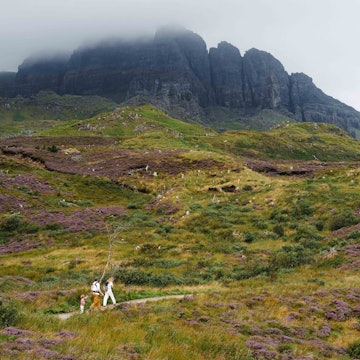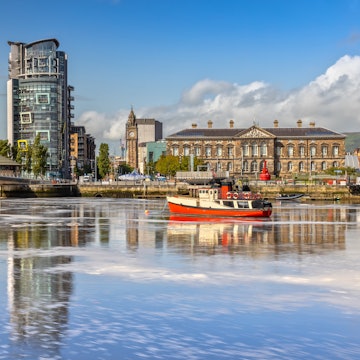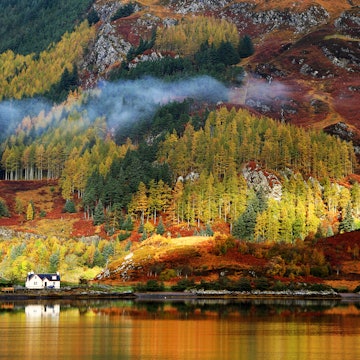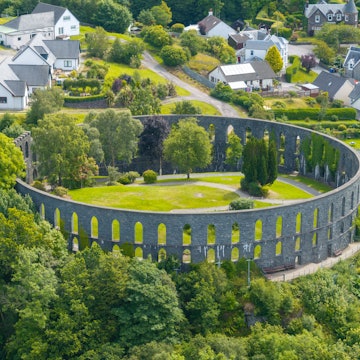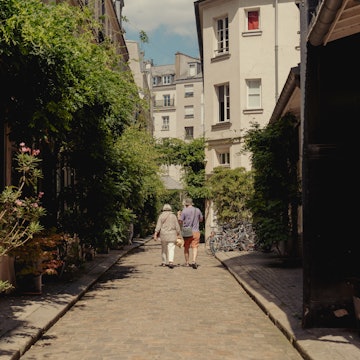
The Lonely Planet guide to Loch Lomond and the Trossachs, Scotland



Island-dotted Loch Lomond is a playground for hikers and water sports and boating enthusiasts. Sky View Video (Scotland)/Getty Images
Serving up an all-you-can-explore banquet of sprawling lochs, mountain trails, lush glens and precious woodland, Loch Lomond & The Trossachs National Park captures all the classic, showstopping scenery you’d expect from the Scottish Highlands and then some.
Officially established as a national park in 2002 and now one of the most popular tourist destinations in Scotland, the scenic area around Loch Lomond and the rugged hills of the Trossachs is thoughtfully managed to protect and enhance the natural environment, preserving a wonderful variety of wildlife habitats and farmed landscapes.
Blending into this wondrous world of nature are pretty towns and villages, historic pubs, and activities to suit every age, ability and interest. As the national park is so close to the Central Belt – just 26 miles (42km) from central Glasgow – this is where many Scots get their first taste of the great outdoors, and it’s one of the top places to explore in Scotland.
This diverse medley of landscapes and experiences will go far beyond your wildest Scottish daydreams. Here’s how to get the most out of a trip to Loch Lomond and the Trossachs.

What’s the history of Loch Lomond and the Trossachs?
Despite its vast expanses of unspoiled nature, Scotland has just two formally designated national parks – Loch Lomond & The Trossachs, and Cairngorms National Park. Loch Lomond was Scotland’s first national park, established to protect landscapes on both sides of the Highland Boundary Fault in 2002.
Covering 720 sq miles (1865 sq km), it’s the fourth largest national park in Britain, spanning lands once controlled by the Duke of Montrose, the Colquhouns of Luss and the MacGregor clan – including their most famous clansman, the legendary outlaw Rob Roy.
How do I get around Loch Lomond and the Trossachs?
The national park is a road-trippers’ dream, with incredible drives all around the lakeshore and across the mountains, and scenic viewpoints along the way. Coming from central Glasgow, just follow the A82 northwest; from Edinburgh, take the M9 as far as Stirling, then follow the A811 over the glens.
Alternatively, Loch Lomond can easily be reached from the Central Belt via public transport. ScotRail services run from Glasgow to Balloch, Arrochar & Tarbet and Ardlui, while Citylink operates buses from Glasgow to Balloch, Luss, Arrochar, Tarbet and Inverarnan.
To explore, take a scenic drive, hit the trails on a self-guided hike, discover the national park on a guided day tour with Scotland’s Wild, or use the Cruise Loch Lomond waterbus to hop around Loch Lomond’s islands and shorefront villages. The renowned West Highland Way long-distance trail from Milngavie to Fort William also passes through the national park.

When should I visit Loch Lomond and the Trossachs?
The summer is the best time to visit Scotland, with dry, warm days that are perfect for exploring on foot. This is also the best – and busiest – time to visit Loch Lomond and the Trossachs. Buses, boats and trains run full schedules, the weather is warm enough for camping, and it’s the perfect time for boat trips, hikes and enjoying the great outdoors.
However, midge season peaks from June to August, so you’ll want to bring repellent to keep off these biting insects at this time. Many visitors prefer to come in the spring or fall, when the bugs are less active and the landscape is livened up by spring wildflowers or autumn foliage, though you can expect more frequent rain and soggier trails.
The national park has a magical beauty in winter, with the glens lightly dusted with snow, but the conditions can be challenging for walking and driving. Still, there are plenty of cozy pubs where you can warm up beside a log fire.
Where should I stay in Loch Lomond and the Trossachs?
The national park is hugely popular with holidaying Scots and visitors from around the world, so there’s heavy demand for accommodation in the peak summer season. You’ll find destination hotels like the loch-side Duck Bay Hotel and the Inn on Loch Lomond in Alexandria; historic country pubs with rooms such as the Loch Lomond Arms in Luss; plentiful B&Bs and Airbnb rentals; and budget bunkbeds and inexpensive rooms at the Inversnaid Bunkhouse.
To immerse yourself in the landscape, there are designated campgrounds – or you can wild camp around the shores of Loch Lomond with a permit from the park authorities. Alternatively, take the experience upmarket in a romantic cabin with a wood-burning stove at the Trossachs Collection in Gartcurrachan. Note that demand for accommodation can outstrip supply, especially in summer and over public holidays, so book accommodation well in advance.
What should I eat and drink on a trip to Loch Lomond and the Trossachs?
Like most protected areas in Britain, Loch Lomond & The Trossachs National Park is dotted with villages and small towns. You’ll find some charming country inns where you can stop for a bite, plus plentiful cafes and kiosks at popular tourist stops such as Luss and Alexandria. The Oak Tree Inn in Balmaha sits close to the route of the West Highland Way and is a great stop for a post-hike burger or pizzas; there’s an adjoining ice-cream parlor and coffee shop, too.
Over in Drymen, the Clachan Inn is Scotland’s oldest licensed pub, and it’s good for hearty meals and Sunday roasts (try the haggis bonbons with whisky cream sauce). In Brig o’Turk, The Byre Inn serves up wood-fired pizza, pints and live music; check if they’ve reopened after taking a break in early 2025. For a posh dinner, head to the Monachyle Mhor in Balquhidder, an award-winning, special-occasion dining spot with beautiful, creative dishes drawing on quality Scottish ingredients.
For lunch while out exploring, swing into the Brig o’ Turk Tearoom in Callander, a charming, restored tearoom from the 1920s that serves hot drinks, home bakes and vegetarian food. Another top brunch stop is The Broch in Strathyre, a family-run establishment offering homemade soda bread, Italian coffee and fantastic full Scottish breakfasts. Over by Loch Goil, The Boatshed is a picture-perfect, Insta-famous cafe where tasty soups, toasties, coffee and cake in the outdoor deck are served with a view.

What are the top experiences around Loch Lomond and the Trossachs?
From soaking up the serene lakeside views to summiting Ben Lomond, here are the best ways to enjoy Loch Lomond & The Trossachs National Park.
Take a wander in the Great Trossachs Forest Nature Reserve
One of the last and largest expanses of native woodland in the country, the Great Trossachs Forest Nature Reserve is the focus of a major regeneration project. Two million trees have already been planted as part of the 200-year plan for this precious forest, which covers 56 sq miles (145 sq km) in the heart of the national park.
Experience the reserve’s rich medley of scenery on the 30-mile (48km) Great Trossachs Path from Callander to Inversnaid, or choose from one of nine waymarked walking trails in Glen Finglas. Try to walk here in early spring to see the woods blanketed with bluebells, or come in October for fall colors. Alternatively, take a leisurely, low-level walk through the woods at Loch Ard near Aberfoyle.
About 6 miles (9.7km) east of Loch Lomond, you can drive along part of the iconic Duke’s Pass, built by the Duke of Montrose to provide access to his castle. The 7-mile (11.2km) Three Lochs Forest Drive takes in Lochan Reòidhte, Loch Drunkie and Loch Achray, and lots of beautiful scenery along the way; vehicles can access the route daily from 9am to 4pm (March to October).
The national park extends across to the remote Cowal Peninsula and the ever-enchanting Puck’s Glen, where a deep gorge, wooden bridges and waterfalls cast a lasting spell. Nearby, Benmore Botanic Garden covers 49 hectares (121 acres) filled with rare plants, vibrant rhododendrons and giant, ancient trees.

Get out onto the water on Loch Lomond
Thousands of visitors gravitate toward Loch Lomond and its bonnie banks, made famous by the much-loved traditional Scottish folk song. Stretching for 26 miles (42km), the loch is the largest body of fresh water in Britain, and it’s a gorgeous spot to explore by boat, especially when the sun puts in an appearance. Kayaks, canoes, SUPs, rowboats, motorboats, water skis and wakeboards can be rented from Loch Lomond Leisure at Luss on the western shore.
Loch Lomond’s vast expanse of water is sprinkled with 22 islands and 27 islets; cruise the loch for a closer look. Sweeney’s Cruises runs boat trips from Balloch, while Cruise Loch Lomond offers a range of cruises and water-bus services from various locations around the loch.
From Luss, you can take the waterbus to Inchcailloch, an island covered by a scenic national nature reserve. Ascend the short summit path for incredible views of Ben Lomond and Conic Hill, then drop by the island’s ancient burial ground and picnic on the golden-sand beach. Another popular option is the Tarbet to Rowardennan water-bus, which provides access to the trail to the top of Ben Lomond.
For less footfall and more relaxed vibes, the national park has 21 other lochs to choose from as an alternative to Loch Lomond. Loch Katrine is a particularly rewarding detour; take a calming steamship excursion with Loch Katrine Cruises and marvel at the surrounding mountains.
Go wild swimming
Cold-water swimming is a treat amid such sensational scenery, and – if done safely – it’s a great way to appreciate the park’s natural beauty. Several beaches around Loch Lomond are good for swimmers, including those at Luss, Firkin Point and Inveruglas. Just remember to be cautious of boat traffic: using a bright-colored tow float is a sensible precaution.
Off the A811 between Loch Lomond and Stirling, Lake of Menteith and Loch Venacher have safe entry points, attracting cold-water swimmers from spring to fall. Just north, Loch Lubnaig – a slender slither of water between forests and rounded mountains – is another favorite spot for local wild-swimming groups with a pretty shingle beach. Take the plunge, then warm up with a hot drink from The Cabin on the lakeside.

Camp out on the loch shore
To fully immerse yourself in the magic of Loch Lomond, camp on its shores – the nighttime quiet will lull you into peaceful slumber and you’ll awaken to the sounds of nature. Subject to seasonal regulations, wild camping is permitted in special Camping Management Zones around the national park from March to September – a delightful alternative to staying in a formal camping ground.
To camp within these popular areas, you’ll need to apply for a permit online. Plan well in advance if visiting during peak summer, as demand often outstrips the number of available spaces. At other times, wild camping is permitted across the park so long as you follow Scotland’s Outdoor Access Code.
For a little more comfort, waterside campgrounds with toilets, drinking water supplies and washing up areas are available in locations such as Loch Chon and Loch Achray; book well ahead via the national park website. The popular Sallochy Campsite benefits from a sheltered oak woodland setting, with easy access to a sandy beach on Loch Lomond’s eastern shores.
Follow in the footsteps of Rob Roy
The historic cattle-droving roads of the Trossachs were once a stomping ground for the Clan MacGregor – and most famously, the outlaw and folk hero Rob Roy MacGregor. Born in the village of Glengyle in 1671, Rob Roy was a skilled cattle thief and an exceptional swordsman who ran protection rackets but used the proceeds to support his community.
A Scottish version of Robin Hood, Rob Roy and his exploits were romanticized in the writings of Sir Walter Scott, and played out on the big screen in the 1995 film Rob Roy starring Liam Neeson. Walk in his footsteps with a drink at the Drovers Inn in Inverarnan, a reputedly haunted 300-year-old pub once frequented by the outlaw, and visit his final resting place in the graveyard at Balquhidder Old Kirk.
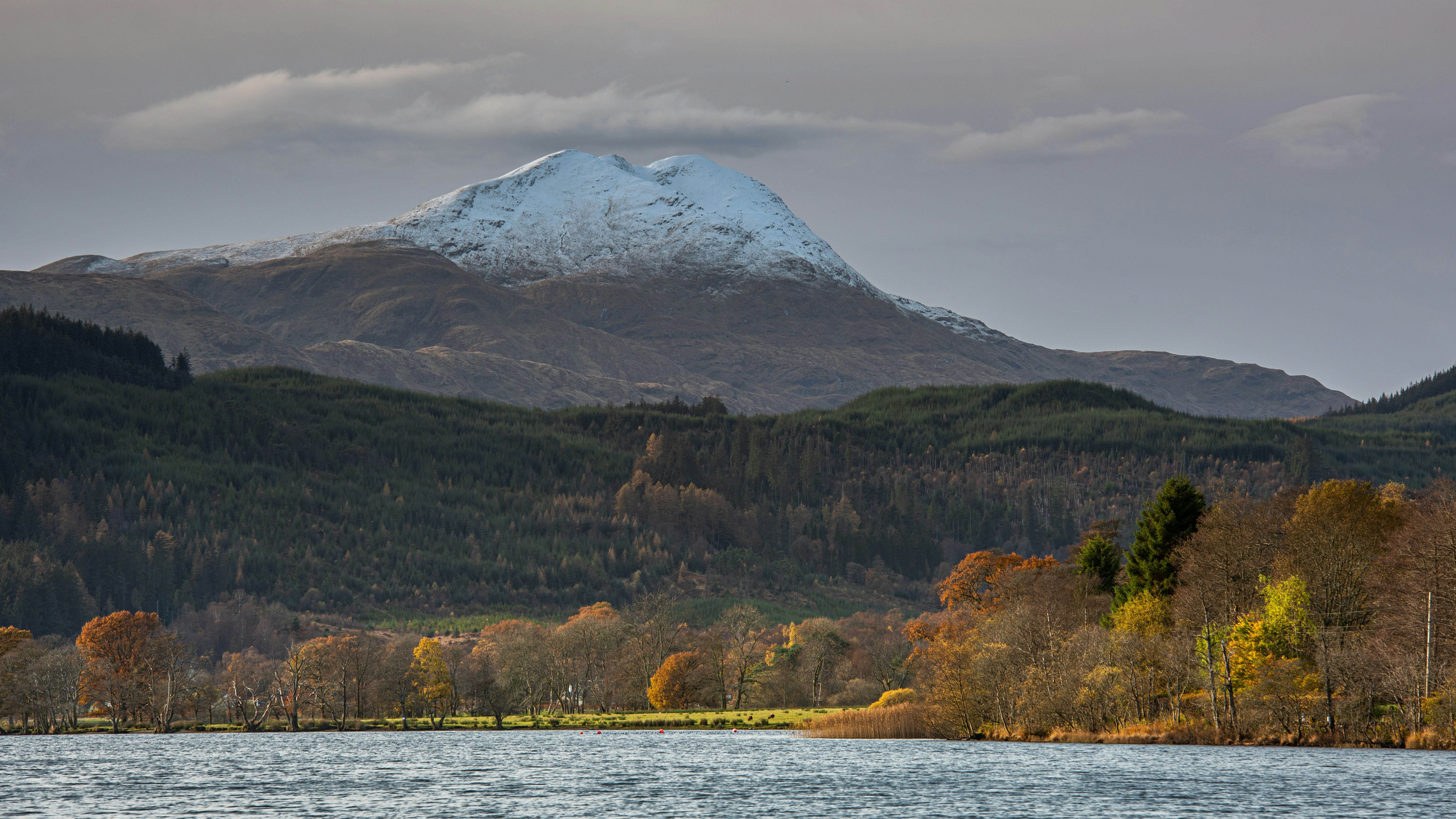
Give your legs a workout on the hike up Ben Lomond
If you’re up for a challenge, 3195ft (974m) Ben Lomond is Scotland’s southernmost Munro – the local term for any peak over 3000ft/914m in Scotland – and it looms over the eastern shore of Loch Lomond, just north of Rowardennan.
It’s the closest proper climbing mountain to Scotland’s Central Belt, attracting legions of hill walkers from Glasgow, Edinburgh and further afield, particularly in summer. The easiest way to reach the trail to the summit is via the Rowardennan water-bus from Tarbet on the western shore of Loch Lomond.
Starting from Rowardennan, the 8-mile (13km) hike to the summit and back takes four to six hours, with stunning views as a reward for 3050ft (930m) of elevation gain. Sometimes the views stretch for miles, but at other times, the summit is cloaked in cloud. On some magical occasions, the summit walk will take you through the mist out into the sunshine, revealing views over a Loch Lomond–shaped cloud bank below.
Another rewarding hike is the ascent of 361m (1184ft) Conic Hill, inland from Balmaha. You can complete the 3-mile (5km) return hike to the summit in two to three hours, including time to stop and admire the loch views, or make a longer 6.5-mile (10.5km) circuit around the hill, following sections of the West Highland Way.
Are Loch Lomond and the Trossachs accessible?
The national park authorities are making a concerted effort to open up the loch and mountains to people with disabilities, with accessible visitor centers and toilets; lots of level, step-free trails; and dedicated wheelchair and stroller routes such as the loch-side path at Firkin Point.
Parts of National Cycle Route 7 and the West Loch Lomond Cycle Path are also accessible for wheelchairs, and accessible rental cottages can also be found all around Loch Lomond. However, walking trails to higher elevations such as the path up Ben Lomond are only open to fit and mobile hikers.
This article was adapted from Lonely Planet’s Scotland guidebook, published in June 2025.










